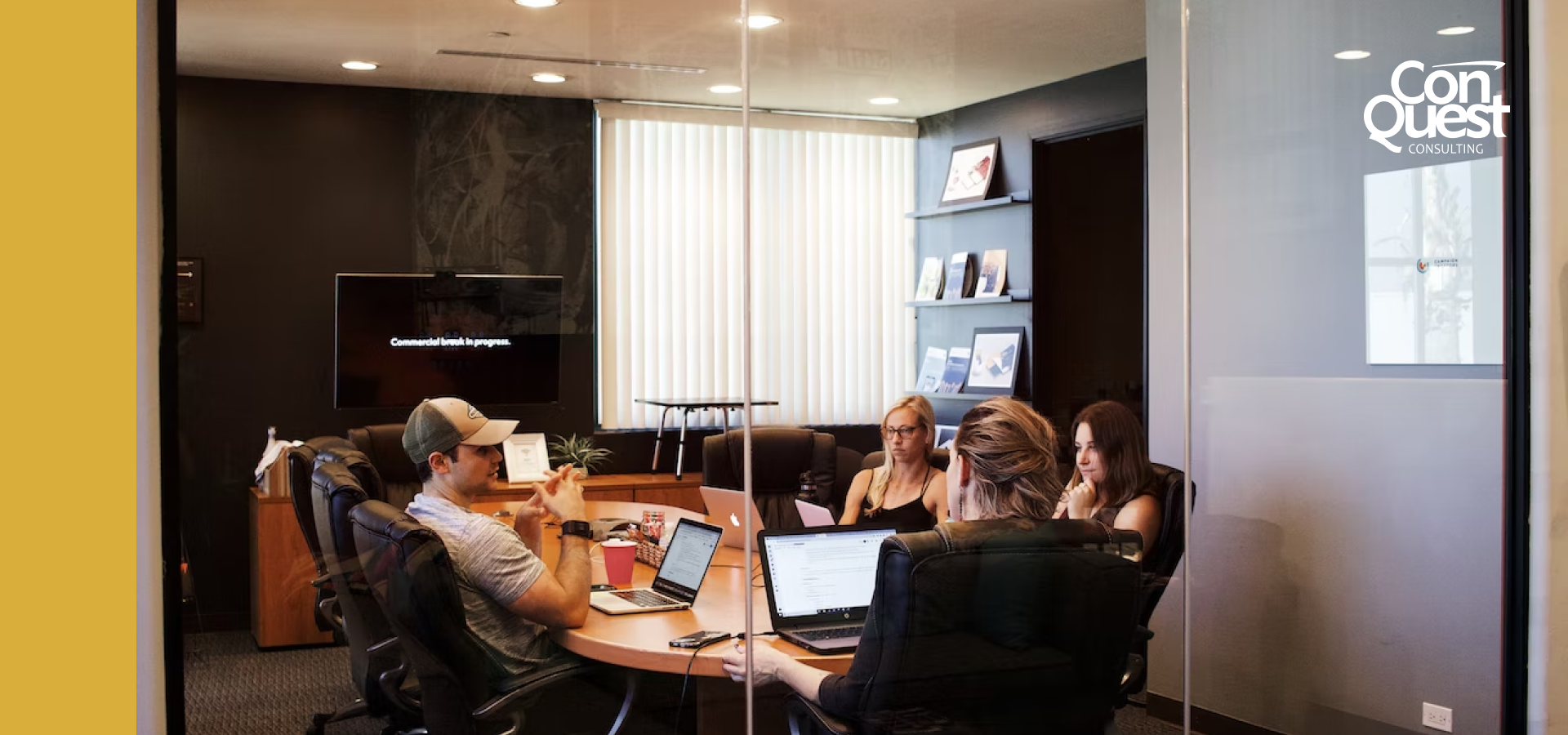12.06.2021
Competitive analysis in a few steps
Key information:
- Competitive analysis is the process of studying the activities and strategies of companies in an industry to understand the market and competitive advantage.
- To identify competitors, look for companies offering similar products and services in the market.
- In competitive analysis, it is important to create an overview of the company that describes its business. Use the website and competitors' product catalogs here.
- Product promotion strategy is a key element of marketing. When creating it, it is worth following the actions of competitors to avoid mistakes and implement innovative solutions.
- To conduct a competitive analysis, it is worth collecting both current and historical customer data, which can be achieved through marketing messages.
- Competitor research also includes analyzing the sales tactics a company uses, which helps to understand where a company stands competitively.
- One of the most important stages of competitive analysis is the study of a company's financial performance. It allows you to assess the company's growth prospects.
- Tools such as SWOT, comparative analysis or market environment analysis can be used to conduct a competitive analysis.
Details below!

It is well known today that competitive analysis is one of the key issues when establishing a company or acquiring new markets. A thorough knowledge of the companies with which we will be competing for customers will, among other things, allow us to predict their next moves, take advantage of weaknesses or draw good patterns, which in the future may result in achieving a competitive advantage.
What is a competitive analysis?
It is a series of activities aimed at obtaining as much information as possible regarding companies competing in the market with a given enterprise. During a competitive analysis, it is usual to examine:
- product offerings,
- prices,
- marketing strategy,
- market position,
- target group.
However, this is an example of strategic competitive analysis. In many cases, such a study is performed in a more specialized way taking into account such aspects as SEO analysis or link analysis, for example, and many others
Why do a competitive analysis?
Competitor analysis is essential for any business wishing to operate effectively in the market, gain a competitive advantage and achieve success. Such a study allows to understand the situation in the market and identify other companies operating in the industry, so entrepreneurs can better tailor their products or services to the needs of customers.
In order for a competitive analysis to be useful in the subsequent decision to enter the market, it should provide us with comprehensive information about potential rivals, that is, cover as many areas of their operations as possible. In the rest of this article you will find the steps you can't skip.
How to conduct a competitive analysis?

Identification of competitors
The first step to conducting a competitive analysis is to identify your competitors. You can choose much larger or smaller companies than yours, but if you have a wide range of competitors, choose companies similar in size to your business. It is worth remembering that there are two types of competitors: direct and indirect.
A direct competitor is one that offers the same product or service and targets the same customer base as our company. An indirect competitor, on the other hand, is one that sells similar products, but targets a different customer sector, or sells different products and services, but uses the same customer base. Recognizing and analyzing indirect competitors is important because it gives you a different perspective on your business or customer base.
Competitors' products and services
For each competitor, create an overview that describes its business. It should highlight the characteristics that make each organization a competitor. Use your own knowledge and market research to do this. It is also fundamental to know the specifications and price of the products and services offered by your competitors. Use the website, product catalogs, or competitors' establishments for this. It is also a good idea to subscribe to the newsletter of the company you are analyzing. Determine which competitor's product or service is most popular with customers. What features make a particular offering so competitive? Is it quality, price, distribution method, or perhaps unique added value? Try to capture as many elements as possible that you can implement in your own company, as well as those that give you an edge. Remember, when conducting a competitive analysis, it's the details that most often make the difference.
Product strategy
Product promotion strategy is one of the components of marketing, which is directly responsible for effective sales, and can help us conduct a competitive analysis. It is a field that offers a wide spectrum of the most diverse ideas for creating and meeting the needs of both the company and customers. However, it is important to remember that while brilliant, effective solutions bring big profits, ill-advised decisions can lead to financial troubles. Choosing the right product strategy is an extremely responsible task. However, this does not mean copying other companies' solutions for your own campaign. A product promotion strategy is something that should be unique in the first place. Something that should distinguish the company from the rest of its peers. So why follow your competitors' doings when it comes to product promotion? First of all, it is useful to know what distribution channels and types of advertising have not worked in the past. In this way, we will avoid some misguided decisions. It is also good to be aware of what solutions competitors have never used. Implementing them will make our strategy innovative and unusual in the industry, and this is already a big added value.
Customers
What customers are your competitors reaching and how many are there? It's best to gather both current and historical data. You can do this by, among other things, analyzing the company's marketing communications. This will help you notice how a competing project developed and how long it took before it reached a specific number of customers. Read comments and feedback on the content published by the company. In this way you will find out whether the product of the analyzed company meets the needs of the customer. Very often at this stage the competitive analysis shows that the company is developing too slowly.
Sales tactics
A well-conducted competitive analysis also includes the sales tactics used by competitors to sell their goods or services. Analyze a particular company's sales process and find out how diverse distribution channels they use. In addition to the website, do they have their own outlets, if so - what is their location and what might that be? Is the company's product range available throughout the country, or does the company also sell abroad? Does the company regularly introduce price reductions on its products? Examine the pricing strategy of the company under analysis. Consider the cost of supplying items, the company's plans, subscriptions and any packages. This type of information will help you understand how competitive the sales process of the analyzed company is.
Target group
The target group defines the potential addressees of our products or services. Knowing the common characteristics of our customers allows us to modify the characteristics of the goods and apply specific marketing strategies so that they suit the recipients and allow us to increase sales. It is not difficult to guess that the highest sales are accompanied by the best possible knowledge of the needs of potential recipients. This task is not one of the simplest, and it is extremely responsible and greatly affects the ultimate success of the entrepreneur. In order to avoid mistakes in determining target addressees, it is worth paying attention to the practices of companies that offer similar products when analyzing the competition.
Knowledge of the size of the target group and its predominant characteristics and expectations allows you to adjust your marketing strategy to achieve the best sales results. When studying the profile of a target group, it is advisable to use sets of research techniques and methods that help define the socio-demographic nature, including: lifestyle, geographic distribution or level of loyalty to the product.
Competitive advantage
Another thing no competitive analysis can do without is finding a competitive advantage or niche in the market - this is what will make you stand out. Answer the question of whether your business idea is a good one and whether you have a chance to make a name for yourself in the market with it. Think about what can make you stand out in the eyes of customers compared to your competitors. Perhaps it will be an innovative product, a competitive price or some other unique feature of your product or service. To do this, you need to be as inventive as possible. This is the moment where techniques for stimulating creativity become particularly useful, the most popular of which is "brainstorming ". Try to create an advantage, something that will allow you to stand out, something innovative that has not been done before.
Funding
The structure of liabilities in a company (especially a start-up) is a source of many dilemmas and doubts. Raising foreign capital is among the necessary solutions when growing a company. However, to what extent is it safe to get into debt? Which obligations can be the most advantageous from the company's point of view? It is worth paying attention to the market and sources of financing for similar institutions by conducting a competitive analysis.
It is worthwhile here to find a "success story" on which you will be able to draw when creating a financing model for your own enterprise. Gather information about when the company you are analyzing was founded and under what circumstances it received financing, as well as how much and from what investor. Analyze the financial performance of your competitors. This will allow you to understand the strengths and weaknesses of the company in question, which helps in assessing the company's growth prospects.
Marketing strategy
Include social media analysis here. Why? Because it allows you to understand how your competitors are engaging their audience and how they are building their image. Also, check how the company you're researching responds to its customers' feedback. By diligently analyzing social media, you can see what topics are currently popular in the industry and use them in your marketing strategy. It's also a good idea to check the functionality of your competitor's website. Does it have a FAQ section? Does the company publish case studies or whitepapers? Or has it recently released an ebook?
Investigate whether the analyzed company has its own blog with materials updated on a regular basis. Check what events the competition is participating in. Or perhaps the company has established partnerships with other companies?
Research tools
Conducting a competitive analysis is essential to growing your business. However, it can be extremely tedious and time-consuming - especially if you are looking at multiple competitors. Fortunately, there are many online research tools that make this process easier and more efficient. These tools can help you identify competitors, track their content and analyze their results. Using research software saves you time while informing you of the best results for your business.
Competitive analysis - methods
Good tools for conducting a competitive analysis are:
- SWOT analysis, which considers the resulting opportunities and threats in addition to the pros and cons. It helps a company define its position in the market and predict future actions of competitors. You can read about how to conduct a SWOT analysis on our blog, among other things.
- Market environment analysis, which is the process of collecting and analyzing information on external factors that may affect business operations. It includes the study of various aspects of the business environment, such as the macroeconomic, political, social, cultural, technological and environmental environment.
- Comparative analysis - allows us to compare our company's products and services with those of our competitors. It allows us to better understand in which areas our company can improve its offerings.
Contact us if you need a competitive analysis. Gain an edge over your rivals!
If you're curious about what such a survey looks like in practice, check out how we conducted the competition analysis for Bakoma S.A.
It is rare for a business to have no competition at all. Even if it does, it is good to be prepared for its appearance in the future, because in business you should always have a "plan B". Based on the information that competitive analysis provides, you can create your own or improve your existing strategy. Constant monitoring of the competition and the market as a whole will help you protect your own company from possible losses in market share.
Kacper Dobies
See other entries

How does your competition work from the inside? Find out with 4 corners analysis!
See more


